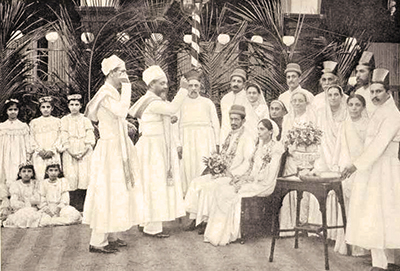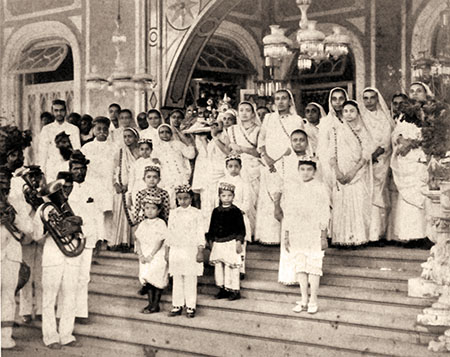Saaro saparmo divas has evolved
Berjis Desai
Dosu, feeling youthful at 72, decided to end his bachelorhood by marrying
Pervin, 30 years his junior. On the wedding
day he looked rather emaciated in an ill-fitting
dagli and
duckback trousers, as compared to his voluptuous bride. Those days, the entire
moholla (locality) would join in the merriment lasting over six days. The wedding procession was led by Dosu’s sisters-in-law carrying the traditional
ses (German silver tray). A politically incorrect heckler enquired if there was a
batrisi (dentures) in the ses, much to the amusement of the crowd and discomfiture of the hapless Dosu who had to manage a toothy grin.
Until the 1950s, most Parsis found their marriage partners amongst cousins. Genetic inbreeding was as unknown as broccoli bake. Paternal cousins were preferred, which made matters worse. Our paternal
grandmother’s was perhaps the last child marriage in Navsari, then ruled by the Gaikwads of Baroda. The bride was six months old; the groom, her paternal cousin, of course, was 10. She was, rather unwisely, given a wine cake to suck, upon which she nearly choked. In the 1950s, an interfaith marriage was as common as a volcanic eruption. Aristocrats marrying
mudums (foreign wives) were secretly envied but the girl who dared to marry a
juddin (non-Parsi) had no option but to elope. Our father signed as a witness to one such marriage and had to face the wrath of the orthodox for being a collaborator. ‘Register marriage,’ as civil marriages were then dubbed, were deemed silent and shady. The all-Parsi one was widely anticipated as a source of much joy,
gossip and entertainment.
The ladies of the host household would visit the homes of most invitees to extend a personal invite at least a month in advance on an auspicious day (not Fravardin
roz né Fravardin mah). It was called "téru
karva
aayach (have come to give the invite).” In the towns of Gujarat, an elderly mobed would visit different
mohollas and recite the invite sonorously. When the printed
chitthi (invite) first appeared, many lamented the advent of the impersonal invitation. The initial
chitthis, for decades, were printed in red ink on white paper. The quality of paper, printing,
envelope and the ubiquitous postage prepaid reply card indicated one’s socioeconomic strata. The wording was uniformly boring. The lagan ni
chitthi though spawned many bawdy versions, which cannot be fully reproduced in the respected family publication which you are reading; but just to give you a flavor, translate the following into Gujarati: "Our son, Lovji, with a missing vital part, will marry Coomi, again with some missing anatomy, on an amaas and garhan (no moon and eclipse) day at a godforsaken hill where incestuous happenings occur, when dinner will be served
containing an exotic combination involving female buffaloes and bhabraaveli bhaaji (sprinkled with spinach), sparrows and chaarvéla eeda (scrambled eggs).”

Parsi wedding, 1905 Photo: Wikipedia
A modest budget meant Cama Baug, motto
otlo; a shoestring budget meant the
nallo
otlo. The middle class went for Allbless Baug; the upper middle and above for the Colaba Agiary. The venue had to be booked months in advance, as all wanted certain auspicious days. Amongst caterers, the
no nonsense Kaikhushru Bhoot slugged it out with the genial Navroji Patel and his enterprising wife. In the late 1960s, a Rs 10
paatra was drooled over, but you could bargain for a bare minimum of three rupees and eight annas. The Godiwalla juggernaut had not then arrived. In the towns of
Gujarat quite a few mobeds turned
part time caterers, sometimes with disastrous results. Decades ago, there was an eccentric mobed known as Nariman Dagri in Navsari who undercut his competitors to secure plum jobs and invariably ran out of food. In the first sitting, mutton cutlets were served with tomato gravy. In the subsequent sittings, the gravy would go missing; then the cutlet served half; and finally, a fried egg would be dumped on one’s
paatra. Woe
betide those who protested. Dagri would glower and then abuse you as if you were Oliver Twist.
On the other hand, some hosts went overboard in laying out a feast for their
parohnas (special guests) at each of the 18 meals during six days, including one after the marriage. From gluttonous breakfasts running into five courses to out-of-the-mainstream delicacies like
dodhi ma gosht (mutton with bottle gourd),
aleti
paleti (mutton and chicken offals), khichri né
vengna
tambota no patio (yellow rice with tomato and aubergine gravy), papri ma kabab (field beans with mutton kebabs) and bhaji ma
bheja (spinach with goat’s brains) for lunch. We knew of an honest and hardworking gentleman who blew his life savings for his only daughter’s marriage, which was remembered decades after in admiring tones by the
parohnas who did not know that the man and his wife literally starved for the rest of their lives.
A live band was de rigueur. The wealthy preferred the portly Goody Seervai playing the accordion. Later, his competitor was the feisty Nelly Batlivala, a young widow who brought up her children by playing music. Phil Davar was affordable for the middle classes. The masoor
paavs (hoi polloi) preferred Dara and his Darling Orchestra who belted out numbers like "Number 54, the house with the bamboo door” and current Bollywood hits. Dara’s sons, Pervez, the veteran Parsi theater actor, and the late Marzban, the official community crooner, regaled Parsi audiences. It was quite a class event. In the towns of Gujarat, there would be the naan
khatai band of uniformed
ragtags creating an awful cacophony beating tin drums and blowing desi clarinets. The better off of Navsari invited the
takorkhana (brass band) from Surat, who would play some doleful music, totally inappropriate for the occasion. As the marriage house would be bustling with activity, the
takorkhana would be housed in the portico of a neighbor, who would feel privileged at the honor. During those days, the entire
moholla belonged to the hosts. The news of a death in the
moholla would be suppressed if it were to occur on the wedding day. We remember seeing a young boy slapped by his irate mother and being called a liar for loudly shouting that
Pervin’s grandmother had just died. After dinner, men and women joined in singing songs and dancing
garbas, including some bawdy ones abusing the groom’s family. This would be supplemented by old ladies attempting to sing in the Indian classical style for a measly fee; and most listeners wanting to throttle these inflictors of pain. Taro (a holy bull’s consecrated urine) had to be consumed under the eagle eye of the officiating priest, who was at times known to turn glad at the time of giving
nahan (cleansing bath) to the bride, particularly if a young mobed got his terms of reference wrong.

Residents of
Bansda at a child marriage
Collection: Veerangana Solanki; Photo courtesy: Pheroza Godrej
In the 1970s, the towns of Gujarat started to empty. The first of the navjotes began to be celebrated in the ball room of the Taj Mahal hotel followed by Rs 100 a plate buffet on which the Parsis gorged as if they had just broken a seven-day fast; and then cynically complain that they missed the
paatru. The invites became commoditized and indistinguishable from invites of other communities. There were no six-day feasts. Goody and Nelly and Dara Mehta were gone. Music systems blared out popular songs or some Catholic band from Bandra played no Parsi numbers. There are no longer any wedding processions in the
moholla which has a solitary Parsi house.
Madavsaro has been replaced by
mehendi and the
takorkhana has gone silent. Anyone interested in reviving these rich cultural traditions should plan a destination wedding at Udvada.
Berjis M. Desai,
senior partner of J. Sagar Associates, advocates and solicitors, is a writer and community activist.
